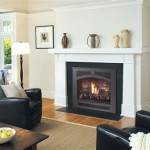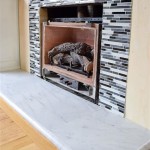Engineered Stone Fireplace Surround: A Comprehensive Guide
Fireplaces remain a focal point in many homes, providing warmth, ambiance, and a touch of elegance. The fireplace surround, the decorative facing around the firebox, plays a crucial role in enhancing the aesthetic appeal of the entire room. While traditional materials like wood and natural stone have long been popular choices, engineered stone has emerged as a compelling alternative, offering a unique blend of beauty, durability, and versatility. This article explores the characteristics, advantages, installation considerations, and maintenance aspects of engineered stone fireplace surrounds.
Engineered stone, also known as quartz surface, is a manufactured composite material primarily composed of crushed natural stone (typically quartz) bound together by a polymer resin. This combination results in a material that retains the aesthetic appeal of natural stone while offering enhanced performance characteristics. Pigments are frequently added during the manufacturing process to achieve a wide range of colors and patterns, replicating or even improving upon the visual qualities of materials like marble, granite, and limestone.
The manufacturing process of engineered stone involves combining the crushed stone aggregate with resin, pigments, and occasionally other additives. This mixture is then molded into slabs of various sizes and thicknesses. Vacuum pressure and heat are applied during the molding process to remove air pockets and solidify the material. The slabs are subsequently polished and finished to achieve the desired surface texture and sheen.
Key Advantages of Engineered Stone Fireplace Surrounds
Engineered stone fireplace surrounds offer several compelling advantages over traditional materials, making them an attractive option for homeowners and designers. These advantages include superior durability, design flexibility, and ease of maintenance.
Durability: Engineered stone is significantly more resistant to scratches, stains, and heat than many natural stones. The resin binder provides a non-porous surface that prevents liquids from penetrating and causing staining. This makes it particularly well-suited for fireplace surrounds, which are often exposed to soot, embers, and spills. The high quartz content also contributes to its scratch resistance, ensuring that the surround retains its beauty even with regular use. Its inherent strength minimizes the risk of chipping or cracking, making it a longer-lasting investment compared to some softer natural stones like marble.
Design Flexibility: The manufacturing process allows for a wide range of colors, patterns, and textures to be achieved with engineered stone. This allows homeowners and designers to create fireplace surrounds that perfectly complement the existing décor of the room. Engineered stone can mimic the look of natural stone, but it also allows for the creation of unique and contemporary designs that are not possible with natural materials. The consistency of color and pattern throughout the slab ensures a uniform appearance, eliminating the variations that are often found in natural stone. Moreover, engineered stone can be easily cut and shaped to accommodate various fireplace designs and dimensions.
Ease of Maintenance: Engineered stone is remarkably easy to clean and maintain. Its non-porous surface prevents the absorption of liquids and dirt, making it resistant to staining. Regular cleaning can be accomplished with a damp cloth and mild detergent. Unlike natural stone, engineered stone does not require sealing to protect it from stains and moisture. This significantly reduces the long-term maintenance requirements and associated costs. The low-maintenance nature of engineered stone makes it an ideal choice for busy households.
Installation Considerations for Engineered Stone Fireplace Surrounds
The installation of an engineered stone fireplace surround requires careful planning and execution to ensure a proper fit and a lasting result. It is generally recommended to engage a professional installer who has experience working with engineered stone and is familiar with fireplace construction techniques.
Preparation: The first step in the installation process is to prepare the fireplace area. This may involve removing the existing surround or preparing the wall surface to ensure it is level and structurally sound. The installer will also need to ensure that the firebox meets all relevant building codes and safety regulations.
Measurement and Cutting: Accurate measurements are crucial for a successful installation. The installer will carefully measure the fireplace opening and the surrounding area to determine the dimensions of the engineered stone pieces. The slabs are then cut to size using specialized cutting tools designed for working with stone materials.Precision is critical to ensure a seamless and aesthetically pleasing fit.
Adhesion and Securing: The engineered stone pieces are typically adhered to the wall surface using a strong adhesive specifically designed for stone materials. The adhesive must be compatible with both the engineered stone and the substrate material. In some cases, mechanical fasteners may also be used to provide additional support, particularly for larger or heavier pieces. Proper adhesion and securing are essential to prevent the surround from shifting or detaching over time.
Sealing and Finishing: While engineered stone is inherently non-porous and does not require sealing for stain protection, some installers may choose to apply a sealant to enhance its appearance or provide additional protection against surface wear. The edges and joints of the surround are typically finished with a color-matched caulk or sealant to create a seamless and watertight seal. This helps to prevent moisture from penetrating and protects the underlying structure.
Maintaining the Beauty of Your Engineered Stone Fireplace Surround
While engineered stone is known for its low-maintenance characteristics, a few simple steps can help to preserve its beauty and extend its lifespan. Regular cleaning and prompt attention to spills can prevent stains and maintain the luster of the surface.
Regular Cleaning: Routine cleaning is essential to remove dust, dirt, and soot that may accumulate on the surface of the surround. A damp cloth and mild detergent are typically sufficient for this purpose. Avoid using abrasive cleaners or scouring pads, as these can scratch the surface of the engineered stone. For stubborn stains, a specially formulated stone cleaner may be used, but always follow the manufacturer's instructions carefully.
Spill Prevention: While engineered stone is stain-resistant, it is still important to clean up spills promptly. Liquids such as wine, coffee, or grease can potentially stain the surface if left to sit for an extended period. Use a clean cloth or paper towel to blot up the spill immediately. For oily spills, a degreasing cleaner may be necessary.
Heat Exposure: While engineered stone is heat-resistant, prolonged exposure to extreme heat can potentially cause discoloration or damage. Avoid placing hot objects directly on the surface of the surround. Use fireplace screens or other protective measures to prevent embers or sparks from coming into direct contact with the stone. Ensure that the firebox is properly insulated to prevent excessive heat from transferring to the surround.
Professional Inspection: Periodically, it is advisable to have the fireplace and surround inspected by a qualified professional. This can help to identify any potential problems, such as cracks or loose joints, and address them before they escalate into more significant issues. A professional inspection can also ensure that the fireplace is operating safely and efficiently.
The flexibility afforded by engineered stone allows for integration with various design styles. For a modern minimalist aesthetic, a sleek, unadorned surround in a neutral color like white or gray can create a clean and contemporary look. Conversely, for a more traditional setting, engineered stone can be used to mimic the look of natural marble or limestone, complete with intricate detailing and moldings. The ability to customize the color and pattern of engineered stone allows for seamless integration with existing architectural elements and furniture.
Beyond aesthetics, consider the practical aspects of engineered stone. Its non-porous nature makes it resistant to mold and mildew, making it a hygienic choice, particularly in areas prone to moisture. The material's durability ensures that the fireplace surround can withstand the wear and tear of daily use, resisting scratches and chips that would be more common with softer materials. This longevity translates to a long-term cost savings, as engineered stone requires minimal maintenance and replacement.
When selecting an engineered stone for a fireplace surround, it is important to consider the overall design of the room and the desired aesthetic. Do you want a surround that blends seamlessly with the existing decor, or do you want it to be a statement piece? Choosing a color and pattern that complements other elements in the room, such as flooring, wall color, and furniture, will create a cohesive and harmonious look. The size and shape of the surround should also be carefully considered to ensure that it is proportionate to the fireplace and the surrounding space.
The thickness of the engineered stone slabs can also impact the overall look and feel of the fireplace surround. Thicker slabs tend to convey a sense of solidity and luxury, while thinner slabs can create a more streamlined and modern appearance. The choice of thickness will depend on the design aesthetic and the structural requirements of the installation. Always consult with a qualified installer to determine the appropriate thickness for your specific project.
Engineered stone fireplace surrounds offer a compelling blend of beauty, durability, and versatility, making them an attractive option for homeowners and designers alike. By understanding the characteristics, advantages, installation considerations, and maintenance aspects of this material, it is possible to create a stunning and long-lasting fireplace surround that enhances the ambiance and value of any home. The meticulous selection of materials, combined with professional installation practices, ensures that the engineered stone fireplace surround becomes a focal point of enduring beauty and functionality. The proper care and maintenance will preserve its elegance for years to come.

Cultured Stone For A Unique Fireplace Royal Oak Mi Fireside Hearth

Natural Stacked Stone Veneer Fireplace Ideas

How To Pick The Best Stone For Fireplaces Stoneworx

Manufactured Stonework For Fireplace Surrounds Skilled Stone Masons

Natural Stone Fireplace Surrounds Hearths Mantels Cabinets Countertops Milwaee
.jpg?strip=all)
Tips And Tools For Professional Stacked Stone Fireplaces

Custom Built Fireplace Surround Install A New Mantel Hearth

Mantels Stone

White Quartz Stacked Stone Veneer For Feature Walls

Modern Fireplace Surrounds To Inspire Your Home








